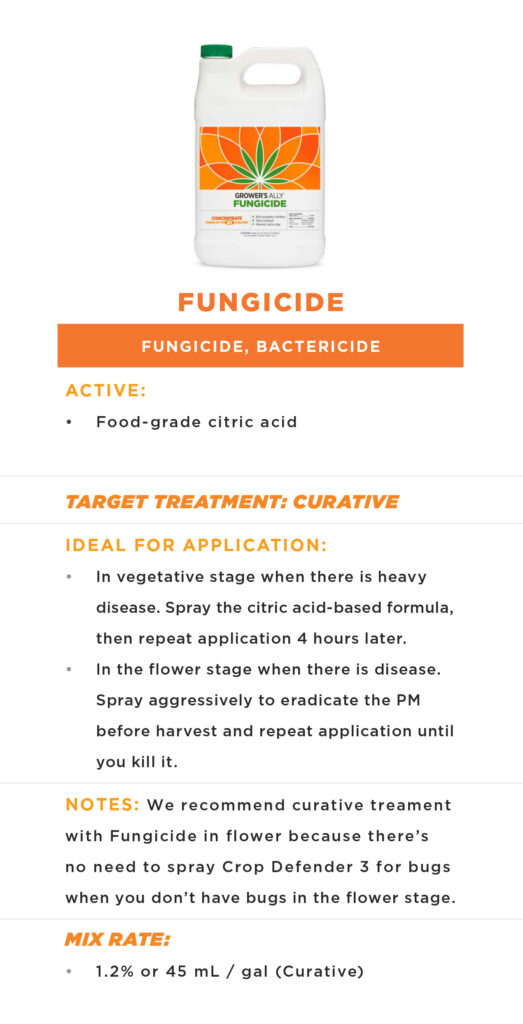
Powdery Mildew, or PM, is one of the most recognizable fungal diseases affecting all kinds of plants. Powdery mildew is particularly common in cannabis plants because unlike ordinary mildew, powdery mildew thrives in warm and dry environments like greenhouses and grow rooms. While many strains have been developed to be resistant or tolerant to powdery mildew, it is one of the most widespread problems impacting cannabis plants at both large-scale commercial operations and small-scale grows.
Powdery mildew is not fatal to your cannabis plants, but it is damaging to plant health. It's like running a marathon with a cold. You can do it, but you won’t perform at your best. Cannabis plants battling powdery mildew will produce less yield and put the purity and potency of your harvest at risk. When you notice trace amounts of powdery mildew, it can quickly become heavy in no time at all if it’s not addressed.
When left untreated, powdery mildew interrupts the function of the plant and its ability to properly transpire. Powdery mildew robs cannabis plants of water and nutrients. The plants weaken and flower production declines. As a cultivator, if your goal is to produce a quality product for end users, powdery mildew needs to be prevented and treated with both environmental controls and safe pesticides to maintain the health of your crop.

Powdery mildew is a fungus. The spores are easily carried by air movement, water, pets and people. It’s important to take curative measures at the first signs of powdery mildew because once a spore lands on a host plant, it will quickly infect the host. Powdery mildew can also be present within plant genetics. These are some environmental conditions that increase the likelihood and spread of powdery mildew:

Powdery mildew first appears as spots or patches of white to gray powder. It often looks like a light dusting of powdered sugar on the plant leaves, both the top and underside, as well as the flower.
Prevention is the first step in treating powdery mildew and your grow room environment is key. Frequent checks by simple visual inspections should become a habit. Here are some environmental tips to make powdery mildew prevention second nature.
Wall-mount fans properly placed throughout your indoor space are key to preventing powdery mildew. Continuous air movement is a must. When you are scouting, powdery mildew generally appears in corners first because of improper air flow to these areas.
Maintain the recommended spacing between plants for your particular type of light. A good rule of thumb is to maintain a footprint of 4-5 plants per light in a garden. More plants do not produce more yield if the plants are unhealthy.
Most indoor grow rooms will have humidity issues, especially when the lights are off because respiration is more intense at night when photosynthesis ceases. Purchase a temperature and humidity meter to monitor levels and stay within target levels.
Humidity Targets
Big swings in humidity levels increase the likelihood of powdery mildew. Keeping air conditioners running when lights are on keeps the humidity down, mimicking nature.
Moving from a room with diseased plants to a clean room is one way to spread the problem. Clothes worn should be sanitized before moving to the next room.
Some genetics have a much higher tendency to get powdery mildew. Researching and paying attention to the genetics is important.
Preventative maintenance is the best way to treat powdery mildew. While in vegetative and flower stages, we recommend spraying a preventative ratio of Crop Defender 3 weekly.
When powdery mildew is first noticed, turn your lights and fans off, then treat with Grower’s Ally Fungicide. After 4 hours we recommend a second application to knockdown the problem.
Considering the environmental controls outlined above, the best way to treat powdery mildew is with safe pesticides. Grower’s Ally Crop Defender 3 and Fungicide formulas are both highly effective, OMRI Listed® formulas for powdery mildew treatment and prevention. If you’re deciding which fungicide is best for powdery mildew, here is a helpful chart to use for your unique grow situation.


There are many DIY remedies on the internet for treating powdery mildew, like milk and baking soda, however these are not fungicides. They are a superficial pH fix that burns the powdery mildew by raising the pH level of the plant on the surface.
With lights and fans off, spray all the plants in the infected room, not just the plants where PM was identified to control cross contamination. One treatment should be sufficient. Then move into your regular maintenance cycle, spraying preventatively every 7 days.
With lights and fans off, spray all the plants in the infected room, not just the plants where PM was identified to control cross contamination. Observe the room thoroughly after the initial treatment and treat the room again the next day. Then move into your regular maintenance cycle, spraying every 3-5 days.
With lights and fans off, spray all the plants in the infected room, not just the plants where PM was identified. With heavy amounts of powdery mildew, treat the affected area, then do a second application 4 hours later. Inspect the plants the next day.


With proper treatment and environmental controls, powdery mildew can be eradicated in 2-4 weeks. If you’d like to discuss treatment protocols or discuss your unique situation with our team, please contact our customer care team or connect with us on social media.
We're committed to protecting people, plants and profits. Grower's Ally will always provide highly effective, all-natural solutions for cultivators. Commercial cultivators can shop direct to grower or purchase our products on Amazon. If you want to see Grower's Ally in your local hydro store, contact our sales team. Stay connected with Grower's Ally on Facebook, Instagram and Twitter for product updates, giveaways and exclusive promotions.
